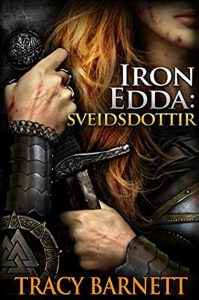Iron Edda: Sveidsdottir by Tracy Barnett (2015, Exploding Rogue Studios) was a novel born out of a 2013 Kickstarter campaign. While I love both Norse mythology and steampunk fantasy, this book was not entirely what I hoped it would be. Originally described as a novel taking place over nine vignettes, the structure of the novel changed over time to focus on the main character, Sigrid, a young Norse woman with the spirit of a Valkyrie within her.
The place where Sigrid, her family, friends, and some enemies live is threatened by attacks of dwarves who control metal constructs. A former member of their community returns and shows them that he can control the bones of a long-dead giant, and invites others to learn to do the same. Sigrid leaps at this opportunity, despite the fact that it means leaving behind her family, friends, and brand-new wife.
Iron Edda: Sveidsdottir purports to be a journey of self-discovery for Sigrid, but the plot makes it feel like it’s more about Sigrid being extremely powerful to begin with, particularly when she learns to control the spirit of the Valkyrie that she possesses. When she then combines that with the power that bonding with the bones of a long-dead giant gives her, she becomes even more of a formidable force, but at that point, the book focuses more on her being powerful than her truly learning anything about herself.
This novel follows not only Sigrid, but also three other point-of-view characters. Unfortunately, the chapters based on other characters’ points-of-view are uneven, and don’t really seem to add much to the story. The early chapters featuring Sabina give a good outsider’s perspective on what is happening, allowing the author to explain some of the features of the culture and the world without it feeling too forced. But the other point-of-view characters don’t really lend much to the telling of the story.
The book features loving relationships between women, including Sigrid and her wife, Ren. Sigrid’s sister is a transwoman who also falls in love with a woman. Unfortunately, the former relationship does not go as planned, and the latter relationship is barely touched on. So while the representation is a positive feature, the details are not all that I had hoped for.
Though written at a young adult reading level, the story is more about adults. However, it doesn’t contain explicit sexual content or particularly graphic violence, so it still seems appropriate for YA readers. Beyond my own criticisms, fans of Norse steampunk fantasy will still find things to enjoy in this book.
Iron Edda: Sveidsdottir is available via Amazon, Drive Thru RPG, and the Exploding Rogue Studios website.
Follow us online:

